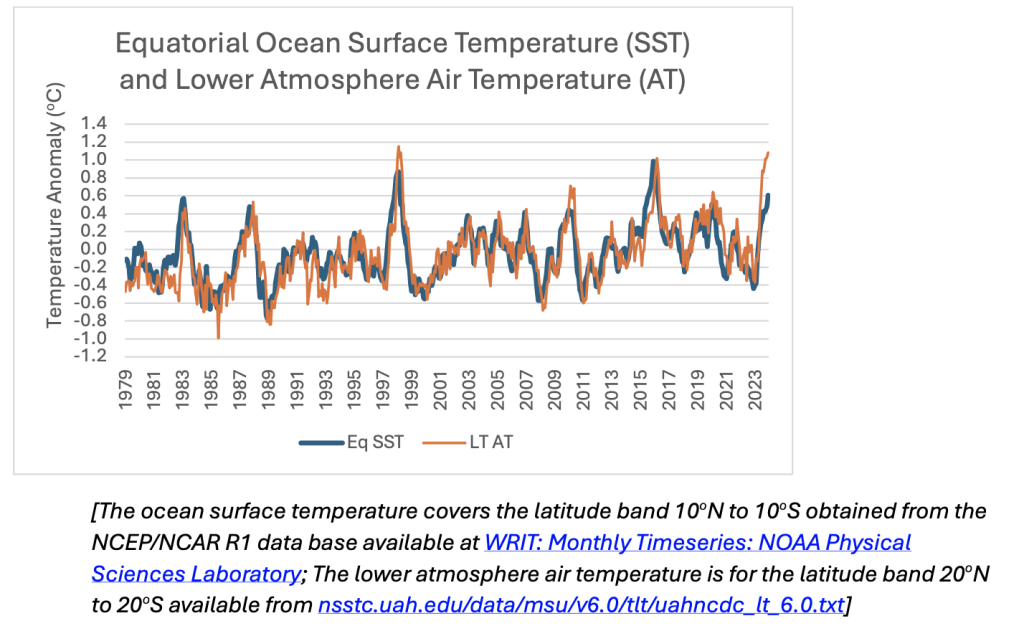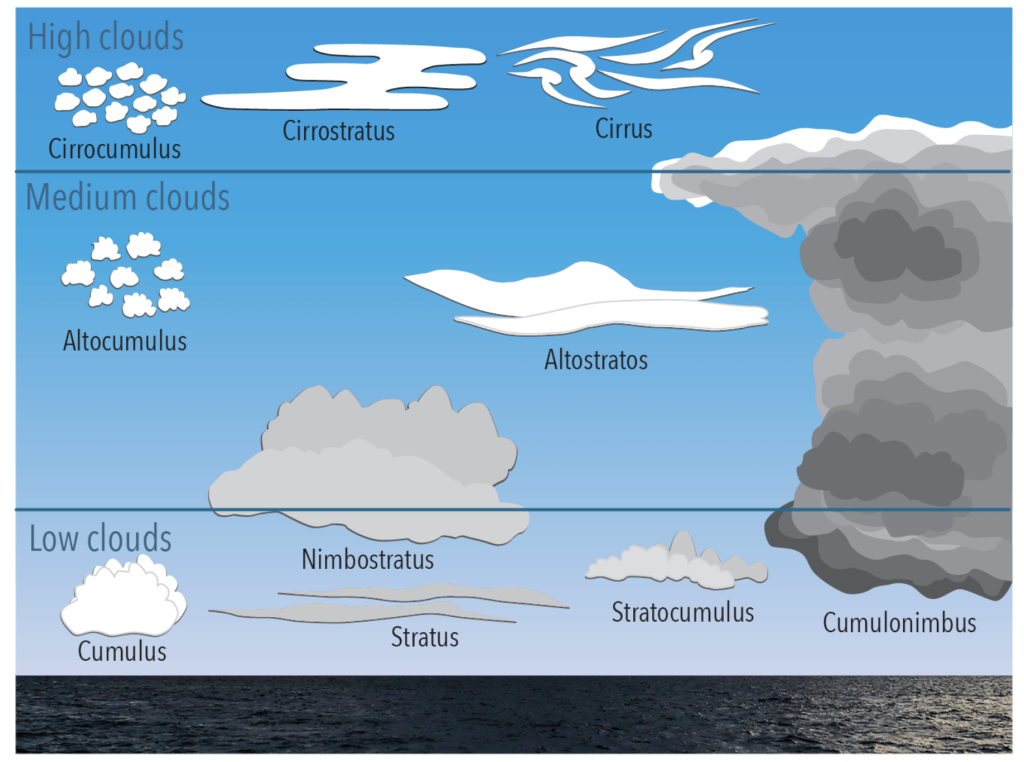One of my interests is in understanding how and why the climate is so stable, for sure it has been over the last several thousand years. Where I live, on the Tropic of Capricorn, daily atmospheric temperatures may fluctuate by 20C, yet the seasonal variation in sea temperatures is less than 10C and if there has been any warming over the last 100 years it is probably less than 2C. For sure the global temperature changes and that is especially the case at the higher latitudes towards the north and south poles. On these points of fact, I am very much in agreement with meteorologist William Kininmonth. We also agree that it is tropical convection, in particular the funnelling of energy from the boundary layer sometimes 13 kilometres straight up to the top of the troposphere that stops the tropical oceans from overheating.
I hosted a first two-hour zoom meeting about these things last night; we are working together towards a new paradigm for understanding weather and climate change.
One hundred registered, the maximum capacity given my zoom subscription, and there were 48 who joined to listening-in, mostly to Bill outline his model of tropical convection and how this is critical to understanding how energy moves within the troposphere and to the north and south poles.
William studied under Herbert Riehl at Colorado State University in the 1960s, and he acknowledges that he is building on the work of Riehl and also Joanne Simpson.
The meeting was at a time that suited William, and an Australian audience. I understand that this time was completely inappropriate for 60% of my Mailchimp subscribers who lives in places like Houston, Texas. I am hoping that I can host William again by Zoom all over again in the New Year and at a time that works for those in Texas.
In the meantime, following is a summary of our first Zoom meeting. This summary was compiled by Zoom’s AI and then I made some additions and edits.
After that there is a link to a Dropbox folder with an unedited audio file and the slides from the presentation.
None of this is tidy – especially not the audio, but it is authentic. And we will improve.
Indeed, we will have to work through the current mess that is climate change science if we are to get to something coherent that has integrity because for sure the climate is not chaotic. For sure it is possible to get closer to the truth, and to develop a paradigm consistent with the data and the laws of physics.
For sure I am tired of the many voices, especially on the right side of politics, that just make stuff-up because they want to be a part of a winning story for their team. Much of what they have written and said will soon become irrelevant.
In the meantime, I am very grateful to the B. Macfie Family Foundation for financial support over a long period of time.
SUMMARY OF ZOOM MEETING DECEMBER 5, 2024
1.Earth’s Climate System and Convection
In the meeting, William Kininmonth presented a model of the Earth’s climate system emphasising the role of convection by air rising within cumulonimbus clouds in the tropical convergence zone straddling the equator. He explained that in the tropics, atmospheric temperatures lag ocean temperatures and that the ocean is regulating the temperature of the atmosphere. Questions were raised about the role of carbon dioxide in the model, William contends that greenhouse gases emit more radiation than they absorb, and that greenhouse gases tend to cool the atmosphere. He stated that this is not contentious within traditional meteorology.
2. Arctic Warming Rates and Seasonal Variations
In the meeting, William discussed the varying rates of temperature change across different latitude bands over the past 45 years. He highlighted that the rate of warming is significantly higher in the Arctic compared to the Southern Ocean, with the Arctic experiencing 6.6 degrees per century and the Southern Ocean experiencing only 0.1 degrees per century. I questioned the data source, to which William clarified that the data is from the National Center for Environment Prediction in the US, combining satellite and surface temperature data. We also discussed the seasonal variation in warming, with the greatest warming occurring in the wintertime in the Arctic and the Antarctic. William emphasised that this is not due to the greenhouse effect, but rather the transport of heat from the tropics. He also noted that the longer growing season due to earlier thaws and later freezes could be beneficial for high-latitude regions like Canada and Russia.
3.Carbon Dioxide’s Role in Climate Change
In the meeting, William discussed the role of carbon dioxide in climate change, presenting a chart that showed minimal increase in radiation absorption at the surface due to carbon dioxide concentration. He suggested that other factors, such as the slowing down of the Gulf Stream, could be responsible for the observed warming trends. Interest was expressed in understanding the physical mechanisms behind these changes and the discrepancy between the model output and the IPCC’s global warming projections.
4. New Climate Change Paradigm Discussion
There was discussion on the concept of a new paradigm for understanding climate change, referencing the work of Thomas Kuhn and the importance of having a clear language and testable theories to move forward. William Kininmonth shared his perspective on the existing climate change theories, emphasising the importance of understanding energy flow and the role of the Equatorial Trough Zone. Christopher Game raised concerns about the use of shorthand in scientific discussions particularly with respect to the word ‘heat’, arguing that it hinders clarity of thought. The group also discussed the Riehl and Simpson paper from 1979, and I suggesting it as a starting point for further discussions.
DROPBOX FOLDER WITH AUDIO
The meeting ran for two hours. The unedited audio, accompanying PowerPoint slides, an essay by William, and relevant technical paper (Riehl and Simpson 1979) can be downloaded from Dropbox here:

About Heat, Comment from Christopher Game
There is a difficulty with seventeenth century thinking that makes heat a property of a body, thinking in terms of heat as a sort of substance called ‘caloric’, is incompatible with heat as a mode of transfer between two bodies, which is built around the 1850 discovery of the notion of internal energy, further clarified substantially by G.H. Bryan in 1907.
The caloric theory way of thinking is widely and deeply ingrained and may be hard to dislodge. This is a truly Kuhnian change of paradigm.
The main defining formulas for clarity:
total body energy = whole body gravitational potential energy + whole body kinetic energy + internal energy.
Thermodynamics is focused on internal energy. The internal energy of a body can change in situ (1) by transfer of matter (evaporation); (2) thermodynamic work; (3) heat (conduction, radiation, friction). The internal energy of a body can be transported in convective circulation, loading up somewhere and unloading somewhere else.
Comments in Conclusion
I emphasised in the meeting that this was just the beginning of the conversation. That my objective is a new paradigm from which to understand weather, climate and how and why it changes and sometimes not at all.
I consider William’s model of tropical convection, with an emphasis on energy transfer from the tropical oceans to the poles critical to understanding weather and climate and why the Earth’s climate is fundamentally stable within limits and especially in the tropics.
I don’t agree with everything that William presented: the measurements that he relies upon to come to his conclusions about temperature trends, or his presentation of temperatures as per century linear trends. I do agree with his emphasis on latitudinal gradients and seasonal trends. I admire how he puts numbers around this, even if I don’t agree with them exactly because I see significant cooling at least in the northern hemisphere from 1940 to at least 1975.
If you would like to listen in to future Zoom meetings with different guest lecturers, consider subscribing to my irregular email news and be sure to tick the box ‘New theory of climate change’.
https://jennifermarohasy.com/subscribe/



 Jennifer Marohasy BSc PhD is a critical thinker with expertise in the scientific method.
Jennifer Marohasy BSc PhD is a critical thinker with expertise in the scientific method.

Thank you for your blog Jennifer,
I look forward with interest to following the progress of this new theory. It makes a lot of sense to an old disgruntled codger who’s tired of listening to the mob.
Ok,
So here we go.
“ Questions were raised about the role of carbon dioxide in the model, William contends that greenhouse gases emit more radiation than they absorb, and that greenhouse gases tend to cool the atmosphere. ”
Greenhouse gases COOL the atmosphere! Yes I read that right and I agree.
How could that be when we are told that the Earth would be 33C cooler than it currently is if there were No Greeenhouse Gases? If so then they are Not Greenhouse Gases and we can hopefully agree to call them Radiative Gases from now on.
There could be a lot of work to do here.
My first tentative step is to suggest that the Radiative Gases are responsible for transferring heat from the surface to the adjacent atmosphere (approx 30 ft depth). My textbook on Aviation Meteorology by Trevor Thom asserts that this is and I think it can be shown.
Deep convection in the atmosphere transfers this heat to the tropopause (known as the Hadley Cell in the Tropics). At this height CO2 can radiate heat direct to space.
I am looking forward to more detail discussions on this subject.
Jennifer,
Thank you very much for organizing this Zoom meeting.
It was more than interesting…
Peter C, you reacted to this
Well, you have been trapped by a (kind of) logical fallacy…
Due to the fact that Greenhouse gases (CO2, but also water vapour, methane, etc.) emit (energy) to space, they indeed “cool” the earth… but,… but,… but… If you understand how the greenhouse effect works… you should know that it is not about cooling, but about less or more cooling when greenhouse gases are more or less present…
To be clear: MORE greenhouse gases result in LESS cooling!!! Or, in other words: WARMING!!
Jennifer,
I admire you for trying to formulate a new paradigm… but I have the impression – hope I am wrong – you want to end up with a storyline without CO2.
This would be disastrous…
There are 3 ways of energy transfer: conduction, convection and radiation.
To outer space, as far as I know there is no conductor 😉.
Convection is available up to what is known as TOA (top of atmosphere).
So the ONLY way for the earth to loose energy is by radiation…
And this means CO2 – read: greenhouse gases (including water and ice in clouds) – should be a prominent part of the story.
(Ant)artic warming rates look quite dramatic the way they are presented by William Kininmonth, but maybe it would be interesting to consider the surfaces that are behind the different latitude bands:
Near surface (2 metre) warming trend (°C/century) by latitude band
Latitude Band 60N>90N 30N>90N 10N>30N 10S>10N 30S>10S 60S>30S 90S>60S
Trend 6,6 2,5 1,6 1 0,5 0,2 3 1,65
Weighted
Area (%) 6,70% 18,30% 16,32% 17,36% 16,32% 18,30% 6,70%
So the weighted warming rate is not dramatic at all… Certainly far below what the IPCC is trying to scare us off with…
My conclusion is quite simple: the earth is WARMING… hurray, hurray… the positive effects outweigh by far the negative effects… Doomsayers, SHUT UP!! for ever…
Jennifer,
That’s true if you use the vernacular definition of chaos, i.e. the climate is not “confused and disordered”.
But chaos has a technical meaning, and it’s about unpredictability, not randomness. Typically it involves a system with well defined rules, but the system is unpredictable because tiny differences in inputs can yield very different results.
My go-to example is the double pendulum, e.g.: https://www.youtube.com/watch?v=3M8nUjYYTgU.
That video has a perfect physics model, yet would be useless for predicting what a real-world double pendulum was going to do.
That the temperature has stayed within some “orderly” range is no different from the arms of that pendulum staying within their orbits. It can still be chaotic.
The table is quite difficult to read, so try this link:
https://www.dropbox.com/scl/fi/92n7qm16y0aeauei2tt7e/JenniferBill.png?rlkey=honey8xkdd4rvgg8enwna7arc&dl=0
Jennifer
Thanks for the presentation.
Can I suggest you try and get Yong Zhong of Yong Tuition to give a presentation.
He has some interesting ideas on atmospheric radiation.
5. Conclusion.
Recent global warming has its origins in ocean warming, is natural, and has nothing to do with changing atmospheric carbon dioxide concentrations.
In fact the trends in reduction of cloud cover is mostly responsible for the warming of the oceans over the last 40 years
Roles of Earth’s Albedo Variations and Top-of-the-Atmosphere Energy Imbalance in Recent Warming: New Insights from Satellite and Surface Observations
by Ned Nikolov and Karl F. Zeller https://www.mdpi.com/2673-7418/4/3/17 and
IRRADIANCE VARIATIONS DUE TO ORBITAL AND SOLAR INERTIAL MOTION: THE EFFECT ON EARTH’S SURFACE TEMPERATURE – Gerald E. Marsh both show this effect and its resulting increase in shortwave absorption and increasing temperatures since the mid 1980s.
In the latest WUWT (7Dec) Haapala raised an interesting thought about Bill’s presentation, namely that water is involved in two distinct processes. One is the water cycle of evaporation, convection and condensation which releases latent heat. The second is the interaction between heat radiation (IR) and individual H2O molecules which can absorb and emit IR at a wide range of wavelengths and that collisions with atmospheric molecules can energize H2O molecules causing them to radiate IR, but equally, collisions can remove energy, reducing the amount of IR emitted by H2O
I’m not entirely sure I understand how this changes what Bill is saying but would be very interested to hear if anyone does?
Ken Haapala is an admirable and diligent worker towards debunking the man-made carbon-dioxide-emisssions global warming myth, but he isn’t necessarily on top of the scientific details. Here follows a snip from his TWTW. I will follow the snip by an attempt to criticise it.
Clip begins
Two Processes Not One: On her blog Jennifer Marohasy posted an audio interview with William Kininmonth with summaries and slides. Kininmonth was the head of Australia’s National Climate Centre at the Bureau of Meteorology from 1986 to 1998. He asserts that oceans warm the atmosphere as opposed to the atmosphere warms the oceans as claimed by many global warming advocates. The infrared radiation given off greenhouse gases cannot penetrate beyond a few centimeters of ocean, fractions of an inch; thus, the atmosphere does not warm the ocean, while sunlight and geothermal events at the bottom do.
Unfortunately, Kininmonth combines two properties of water vapor; one property applies to water vapor alone, the other to all greenhouse gases. This has been a common problems since John Tyndall discovered that certain gases in the atmosphere absorb heat energy emitted by Earth, slowing (blocking) the release of that energy to space; thus, slowing Earth’s heat loss. This explained why the land masses of Earth stay warm enough at night to support growing plants, and life itself. With his experiments in spectroscopy beginning in 1859, Tyndall eventually identified that the dominant greenhouse gas was water vapor, giving rise to the confusion.
Water involves two distinct processes and one, the water cycle, applies to it alone. Water evaporates, creating water vapor which requires heat for the phase change. Thus, water vapor contains what is called latent heat, which is predominantly from sunlight and some geothermal energy. Convection brings it from the surface of Earth into the upper troposphere which is cooler than the surface and lower troposphere. In the upper troposphere water vapor condenses into liquid water giving off latent heat.
The second process of interest is the interaction between heat radiation (infrared, IR) and individual H2O molecules (called water vapor by chemists). Due to a plethora of vibrational and rotational modes of the H2O molecules, they can both absorb and emit IR at a very wide range of wavelengths (“colors,” for lack of a better word). Collisions with atmospheric molecules can energize H2O molecules, which can then radiate IR. Equally, collisions can remove energy, reducing the amount of IR emitted by H2O molecules.
The details of these energy-transfer processes depend on atmospheric pressure, atmospheric temperature, and the exact wavelength under consideration; and are carefully calculated by experts like van Wijngaarden and Happer. Such interactions among molecules and IR are loosely termed the greenhouse effect. However, the greenhouse effect is defined by the IPCC as the numerical difference between the amount of IR emitted by the surface and the amount of IR sent to space.
The work of van Wijngaarden and Happer recognizes the distinction between the water cycle, which is a driver of convection, and the greenhouse effect. Consequently, they are able to demonstrate how water vapor interferes with the effectiveness of other greenhouse gases such as methane and nitrous oxide, rendering them ineffective as greenhouse gases in Earth’s atmosphere.
Unfortunately, William Kininmonth fails to make the important distinction between the role of water vapor in the water cycle and the role of water vapor in the greenhouse effect. See links under Challenging the Orthodoxy – Radiation Transfer and Challenging the Orthodoxy.
Clip ends
I think Ken attributes an aim to Bill that Bill didn’t have. Bill was not aiming at giving an account of man-made CO2 emissions global warming tout court. Bill was just considering one part of the topic, just the limited question: ‘how does tropical vertical convective circulation contribute to the earth’s energy transport process?’ On this occasion, Bill was confining himself to that limited question, and wasn’t tackling the further question of ‘feedback’ that so dominates the climate change groupthink, and is the main basis of the global warming myth. Perhaps Bill might tackle that further question on some other occasion, but it is unfair Ken to criticise Bill for not tackling it on this occasion.
I tried to follow up on Ken’s piece through the “links under Challenging the Orthodoxy – Radiation Transfer and Challenging the Orthodoxy”, but I couldn’t work out what exactly Ken meant by the “link”.
I don’t know exactly what Bill thinks about the further question. But I can make my own comment on it here. The further question concerns the celebrated doctrine of “amplification of the warming by positive feedback through the radiative transfer effects of water vapour”. I am of the opinion, that agrees with Will Happer’s view, that the doctrine is utterly mistaken: there is no such actual eventual overall positive feedback; the actual eventful overall feedback is negative. One needs to distinguish between a virtual or contributory effect in the positive direction, and an actual eventual effect of an overall positive feedback. It is the actual eventual overall feedback that would need to be positive in order to create an actual ‘amplification’. There is no actual eventual overall positive feedback. The actual eventual overall feedback is negative. Bill knows that the feedback through the radiative transfer effect of water vapour is a virtual or contributory effect in the positive direction. Bill’s talk that Ken was criticising was just aimed at establishing that the tropical circulatory convective effect is another important contributory effect that needs to be considered. Bill wasn’t aiming at analysing how it fitted into the overall feedback dynamical structure.
As a layman in these things, it strikes me as “interesting” that sunlight striking the oceans surfasce heats the ENTIRE body of oceanic water “catastrophically”.
Has anyone ever tried to boil a billy of water by heating it from the TOP?. Now, scale that up to trillions of tonnes of water in vessels that range from ankle-deep to MANY hundreds of metres in depth. And not forgetting that the planet actually rotates, on a roughly 24 hour cycle. The “dark” face MUST be radiating heat accumulated from the big thermo-nuke in the sky, during “daylight” hours.
The planet is not just rotating, but doing this on a constant? tilt; all while orbiting said big bomb in the sky, hence “seasons”, as well as day and night. How convenient!
A “Goldilocks” situation.
For the hard-core number-crunchers out there:
https://www.engineeringtoolbox.com/water-thermal-properties-d_162.html
And nobody seems to factor in any contribution from geothermal activity, driven by the “nuclear” fires beneath our feet.
Or have I missed something ??
Bruce, you have missed something…
https://climate.nasa.gov/vsoverlay-ocean-warming/
Why are almost ALL coral reefs in relatively shallow, WARMER / tropical water, globally?
The southernmost coral reef on the east coast of Australia (that I have dived on, anyway), is in Moreton Bay, east of Brisbane, somewhat south of the tropic of Capricorn. It seems to be the beneficiary of warm water that is generated out in the “tropical” Pacific and which forms a huge, circulating current that comes ashore along far-northern New South Wales coast. Hence the whole “all-season” Gold Coast. The very rotation of the planet seems to be responsible for such circular currents. Similar circular currents also exist in the atmosphere. Coriolis effect.
So, how does the “warm” surface water find its way to frigid depths to then, “rise again?
Response to
Karen Klemp says December 13, 2024 at 11:50 am Bruce, you have missed something…
https://climate.nasa.gov/vsoverlay-ocean-warming/
Yes, Karen you are right to point to the existence of an energy storage compartment, the sea, that has in the past not been given too much notice, partly because it has been practically impossible to measure its quantity. The celebrated Kiehl & Trenberth diagram, for example, ignores the storage in that compartment; it doesn’t say that the storage is zero, but just ignores it.
That is about the structure of modelling, and is worthy of more careful attention.
It seems that at present, the atmospheric temperatures are rising. That has been so since 1978, after the end of the cooling period from perhaps 1945 to 1977.
I am not so sure about the sea temperatures.
Other important aspects of our problem are the rates of accumulation or loss of energy in the three compartments, atmospheric, land ice, and oceanic. A three-compartment model is necessary. This amounts to keeping an account of the amounts of energy in each of those three compartments, and of the time rates of transfer between them. (We may add outer space as a fourth compartment.) One can imagine a true zero of land ice energy. For the other compartments, a true zero is hard to imagine, so that we may have to define an arbitrary or conventional “zero”.
Energy storage is one part of thermodynamics, a subject (you might say a paradigm) that began around 1850. The breakthrough was the invention of the concept of ‘internal energy’, based on the distinction between ‘heat’ and ‘hotness’. Clausius denoted internal energy by the symbol U, and this has largely survived in thermodynamics.
Nowadays, in thermodynamics, ‘heat’ is defined thus: heat is energy in transfer other than by thermodynamic work and by transfer of matter. Heat is explained as energy in transfer by microscopic mechanisms, in particular by conduction, radiation, and friction. Heat so defined is not conserved. Thermodynamic work and heat are interconvertible. ‘Hotness’ is measured by temperature.
Convection is often advanced as a mechanism of “heat transfer” but, in the language of thermodynamics, it isn’t so. Convection is a mode of transport of internal energy or one of its free energy Legendre transforms such as enthalpy.
A valuable history is in Clifford Truesdell’s “The Tragicomical History of Thermodynamics, 1822-1854”. In 1850, Clausius wrote (translated): “It is, however, almost impossible to explain the heat produced by friction except as an increase in the quantity of heat.” Also in 1850, before he could have read Clausius’ paper, Rankine used the concept of the interconvertibility of heat and thermodynamic work, and used a mathematical quantity that he called “the thermodynamic function”. Later, Clausius also considered that quantity, and called it ‘entropy’, a name which has stuck.
Because heat and thermodynamic work are interchangeable, in order to track transfers of energy between compartments, thermodynamics needs to keep track of a special variable for ‘hotness’, that we call ‘temperature’, often denoted ‘T’; it has a conjugate variable, entropy, often denoted ‘S’. Their product ‘ST’ has the dimensions of energy.
Thermodynamics is necessary to convert the quantity of stored energy of the land ice compartment to reference temperatures for the other compartments. One might be tempted to speak loosely by saying that land ice stores ‘coolth’ !! Of course, thermodynamics is also necessary to interconvert all the stored quantities of energy to a suitable reference temperature.
Perhaps a suitable reference temperature would be the “equilibrium temperature” of a hypothetical earth devoid of greenhouse gases and with a perfectly black condensed matter surface. It would be useful exercise, though quite a task, to refer the usual quantities of stored energy to that “equilibrium temperature”.
The above is about scientific paradigms, but it doesn’t immediately tackle the question that matters for practical politics, or should I say for practical religion? What is the distinction between religion and politics?